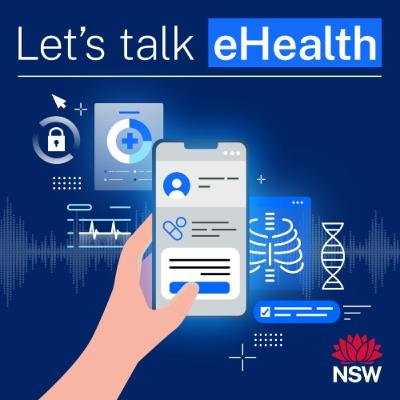Discover Let's Talk eHealth
Let's Talk eHealth

Let's Talk eHealth
Author: eHealth NSW
Subscribed: 8Played: 14Subscribe
Share
© eHealth NSW
Description
Welcome to "Let's Talk eHealth," the podcast brought to you by eHealth NSW. As the driving force behind the digital transformation of Australia's largest health system, we're at the forefront of delivering cutting-edge technology and innovative solutions to improve healthcare.
Join us as we explore the brilliant work being done and feature insights from the talented individuals pioneering these advancements. Listen in and discover how eHealth NSW is shaping the future of healthcare and making a difference in the lives of people across New South Wales.
Join us as we explore the brilliant work being done and feature insights from the talented individuals pioneering these advancements. Listen in and discover how eHealth NSW is shaping the future of healthcare and making a difference in the lives of people across New South Wales.
9 Episodes
Reverse
Almost 1 million clinical images shared and more than 11,000 clinicians already connected - all brought together on one secure, seamless platform called MedSync. In the next episode of Let’s Talk eHealth NSW, host Danielle Johnson sits down with Burns Nurse Practitioner Miranda Pye from Sydney Local Health District and eHealth NSW Product Owner Simon Plummer to unpack the story behind MedSync and how it’s transforming clinical collaboration across NSW Health.Find out more about MedSync: https://www.ehealth.nsw.gov.au/solutions/virtual-care/collaboration/medsync
In this episode, we spotlight the vital role our IT support teams play in keeping digital systems running for NSW Health's 170,000 staff. eHealth NSW Customer Engagement Manager, Bri Gato, shares the frontline impact these teams are having. We also explore how the Customer Feedback Forum program is harnessing staff feedback to drive continuous improvement to IT services. Listeners will hear how changes inspired by staff voices are making a big impact for those delivering critical care.
In this episode, Collaborative success: The SafeScript NSW story, our host Danielle Johnson, Cloud Delivery Manager talks to Mary Fien, Principal Business Analyst in the BA Capability Practice, Program Delivery. Together they discuss eHealth NSW’s journey with SafeScript NSW, the state's real-time prescription monitoring program. SafeScript NSW is an online platform providing prescribers and pharmacists with real-time information about a patient's prescribing, dispensing, and approval history for certain monitored medicines.
In this podcast, we talk about the Patient Reported Measures (PRMs) program that is helping NSW Health deliver value-based healthcare. Delivered through a purpose-built IT platform called Health Outcomes and Patient Experience (HOPE), PRM surveys capture information from people about their healthcare experiences and outcomes at the point of care. Clinicians and healthcare services use this data for shared decision-making with patients and to provide care that meets their needs.
In this episode, we talk to HPC Design Lead Gordon Burnett and Service Designer at NSW Health Pathology Alex Garrett to learn about the Health Prototyping Centre. An initiative between eHealth NSW, HealthShare NSW, Health Infrastructure NSW and NSW Health Pathology, we discuss how the Health Prototyping Centre is enabling customers across NSW Health to rapidly test ideas, designs and concepts before building a final version of the product.To find out more about the HPC, as well as watch a tour video, visit: https://www.ehealth.nsw.gov.au/solutions/research-innovation/innovation/health-prototyping-centre
NSW Health is embarking on the greatest digital transformation in the generation and at the forefront is cloud technology. In this episode, we hear from eHealth NSW’s experts, Adam Stanzione, Director of Cloud Services, Michael Bogiatzis, Director of eHealth NSW’s Critical Infrastructure Refresh, and Daniel Hansen, Senior Program Manager of Cloud Transformation Services. The team unpack some of the basics of cloud technology, starting right at the beginning… they also delve into how cloud is being used to accelerate innovation, modernise service delivery and deliver real world impacts. This is all helping to deliver better outcomes and experiences for patients, clinicians and staff across NSW Health.Find out more on the eHealth NSW website: https://www.ehealth.nsw.gov.au/
Just what is a Chief Clinical Information Officer or CXIO? And how do they support digital transformation within the public health system?This question and more is tackled in this podcast which interviews Dr Sarah Dalton, Clinical lead on the Single Digital Patient Record at eHealth NSW and Peter Edwards, Chief Clinical Information Officer at Western NSW Local Health District and Far West Local Health District and, a CXIO. Both sit down with Hannah Cunniappen from the eHealth NSW communications services team to talk about the important role of a CXIO within the health system. To enquire about becoming a CXIO, email: EHNSW-ClinicalEngagement@health.nsw.gov.au, or contact:Jane DyerA/Director Clinical Engagement | Clinical Engagement & Patient Safety, eHealth NSWEmail: jane.dyer@health.nsw.gov.auPrachi JavalekarA/Clinical Engagement Manager | Clinical Engagement & Patient Safety, eHealth NSWEmail: prachi.javalekar@health.nsw.gov.au
In this week's episode, we explore how eHealth NSW uses behavioral psychology in digital health to build systems that are aligned to people's behaviour, needs, goals and motivations. In this episode, we are joined by Jarrah Watkinson and Loletta Cheng, both User Insights Specialists at eHealth NSW, and psychologists with a background in organisational psychology. About eHealth NSW:eHealth NSW uses information technology to connect people, data and systems to improve patient-centred care in NSW.We partner with health agencies and industry to provide a digitally enabled and integrated health system for patients, clinicians and the NSW community.For more information visit our website: www.ehealth.nsw.gov.auFollow us on:LinkedIn, Twitter and Facebook: @eHealthNSW
When a patient transfers from the ward to the intensive care unit, it’s vital the patient’s medication management information, allergies & adverse drug reactions is also transferred between the electronic systems so clinicians can review and modify medication orders as necessary. This is where the integrated Transitions of Care (iTOC) Design Working Group comes in – their goal is simple but important. They’re working on designing a solution to ensure this information is transferred safely and accurately.










